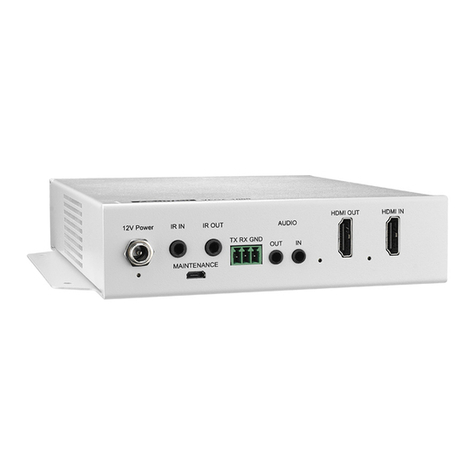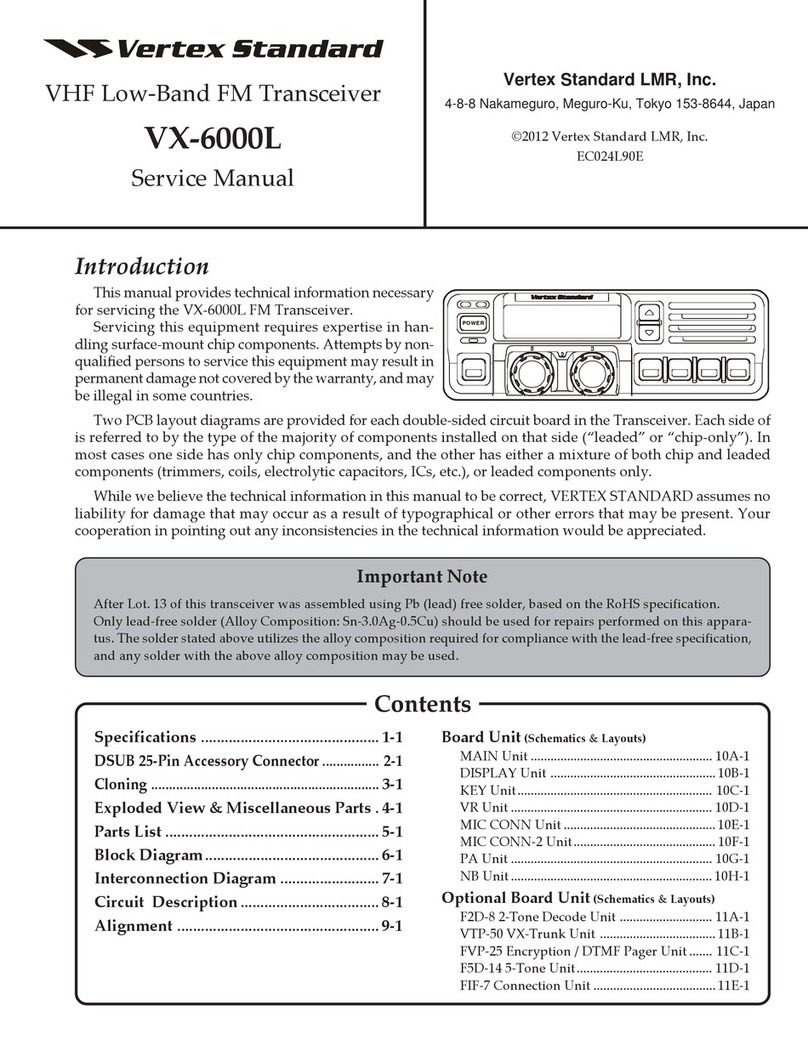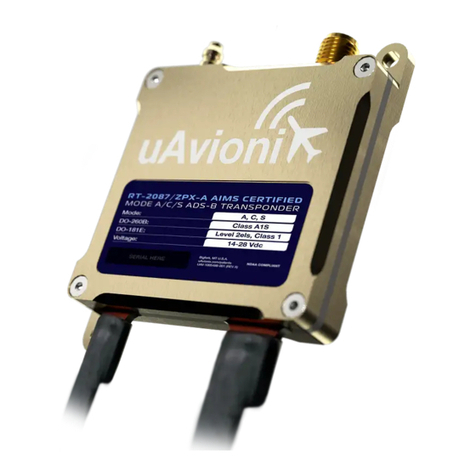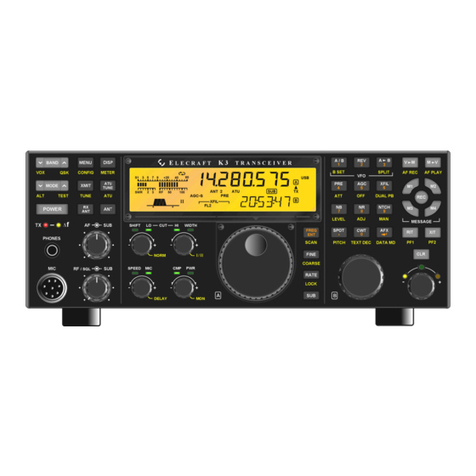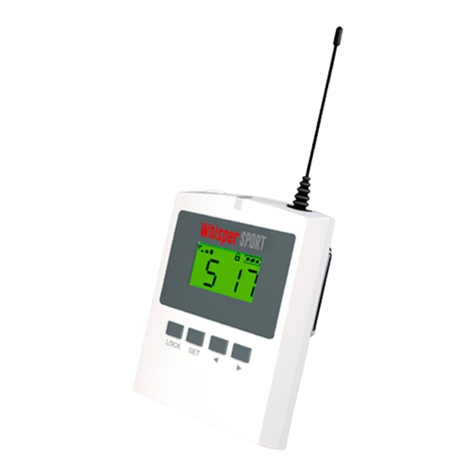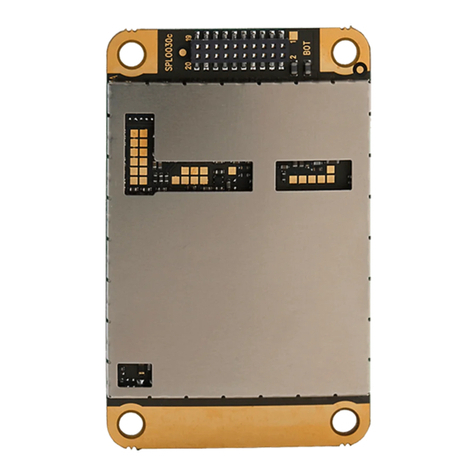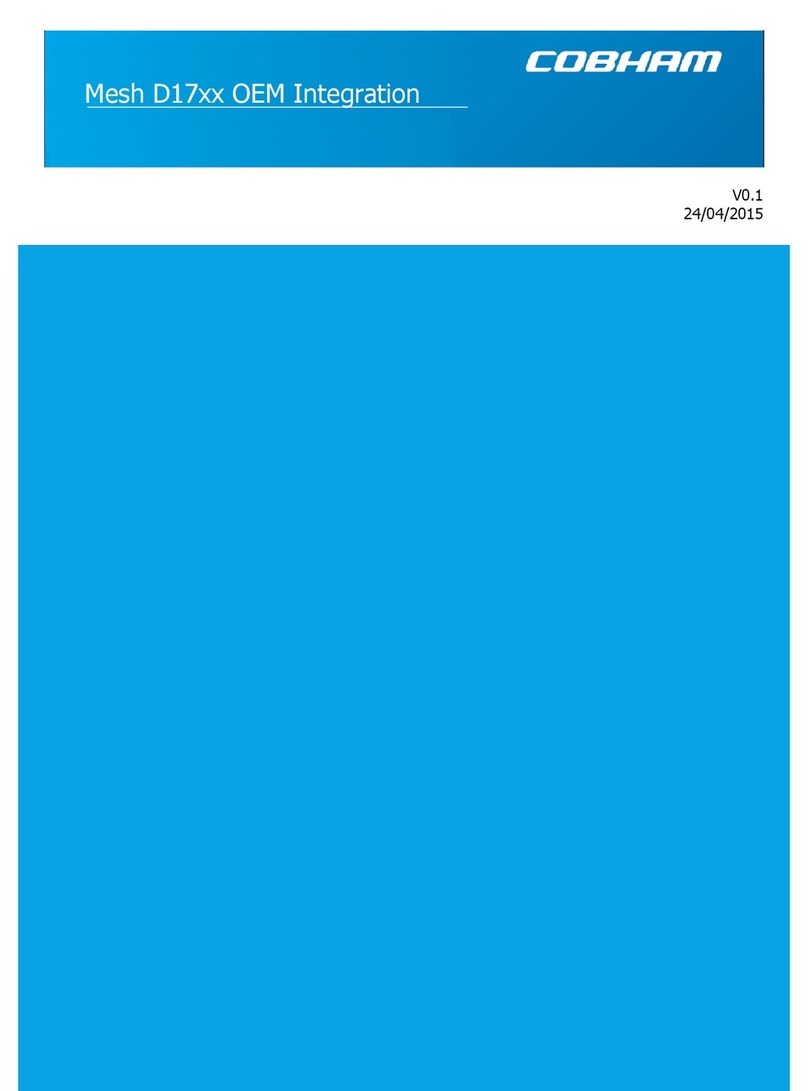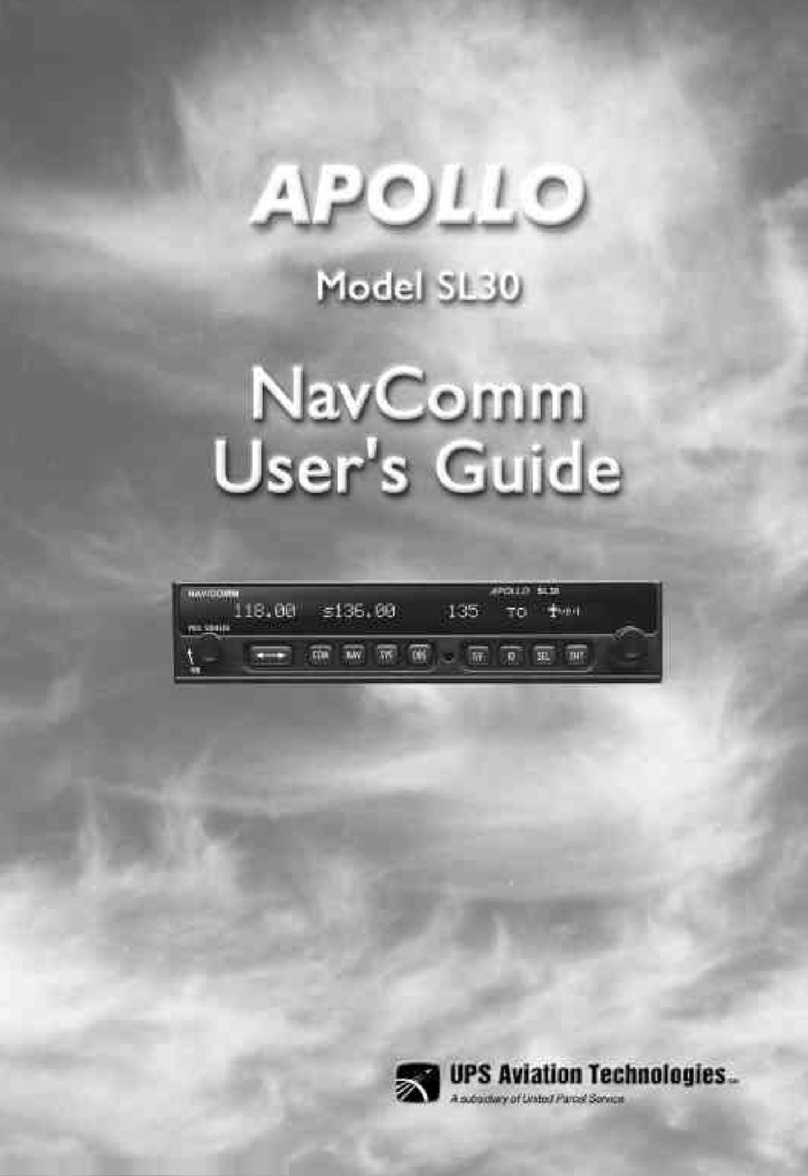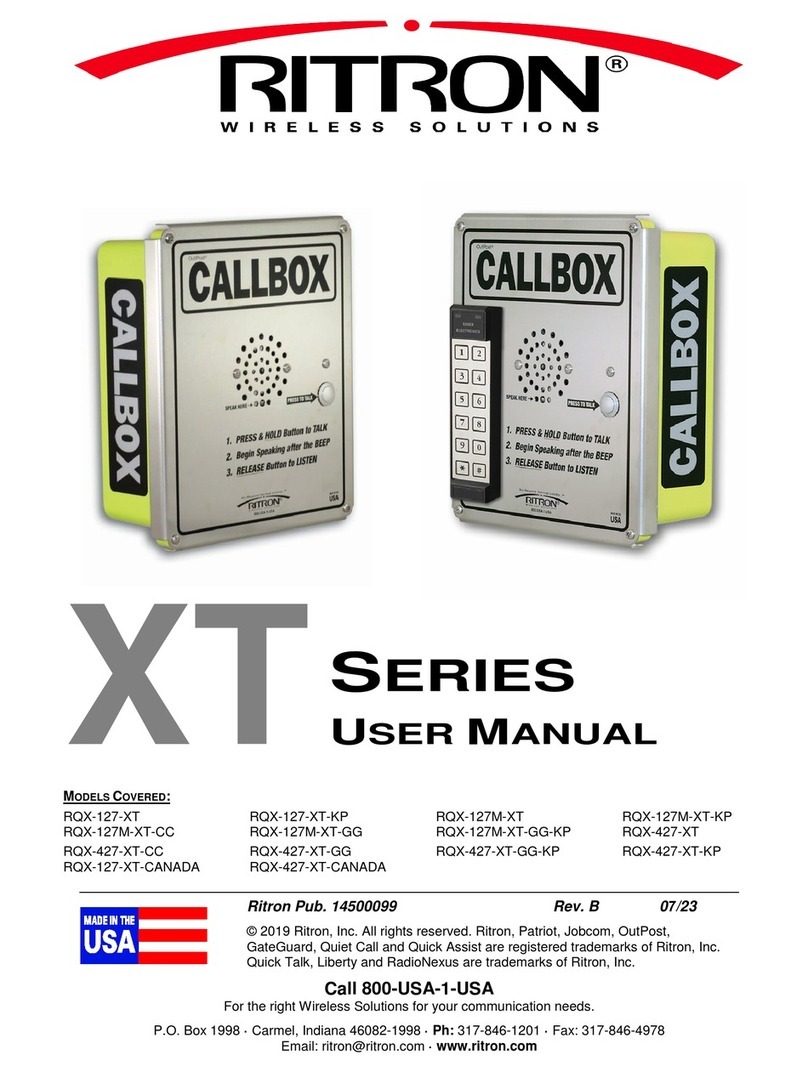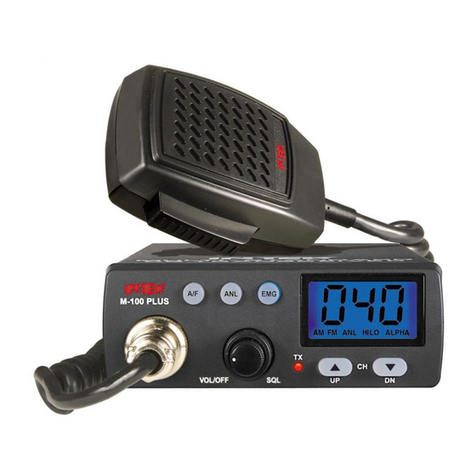Advantech AWMT User manual

INSTALLATION AND OPERATIONS MANUAL
HUB-MOUNT
SOLID STATE TRANSCEIVERS
AWMT
PM AWMT REV. 22

AWMT
1
WARRANTY
This ADVANTECH AMT™product is warranted against defects in material and workmanship
for a period of 2 years from the date of shipment. During the warranty period, ADVANTECH
AMT™will, at its option, either repair or replace products that will prove to be defective.
To return a product for warranty or repair service, you must first request a Return Material
Authorisation (RMA) number by contacting ADVANTECH AMT™at:
Phone: (514) 420-0045 or Fax: (514) 420-0073
The unit should be shipped to the following address, in original shipping container (box), with
shipping charges prepaid.
ADVANTECH AMT™
657 Orly Avenue
Dorval, Quebec
H9P 1G1
CANADA
Please indicate the RMA number on all shipping documentation.
Units shipped without prior issued RMA, or shipped not in original packing, may be subject of
rejection and returned at sender’s own expense.
LIMITATIONS OF WARRANTY
ADVANTECH AMT™warrants this product to be free of materials and workmanship defects.
The foregoing warranty shall not apply to defects resulting from improper handling or abuse by
the Buyer, unauthorized modification, operation outside of the environmental specifications for
the product, or improper installation or maintenance.
ADVANTECH AMT
™
shall not be liable for any direct, indirect, special, incidental or
consequential damages.

AWMT
2
CONTENTS
1. SAFETY ..................................................................................................................................6
2. PACKING LIST.....................................................................................................................8
2.1 SINGLE UNIT PACKING LIST.......................................................................................8
3. GENERAL INFORMATION..............................................................................................10
4. MAJOR SUBSYSTEMS AND THEIR FUNCTIONS......................................................11
4.1 INTRODUCTION ...........................................................................................................11
4.2 DESCRIPTION................................................................................................................11
4.3 UNIT MAJOR COMPONENTS .....................................................................................11
4.3.1 IF to L-Band Up-Converter Module .........................................................................15
4.3.2 L-Band to RF Up-Converter Module........................................................................15
4.3.3 L-Band to IF Down-Converter Module.....................................................................15
4.3.4 Power Amplifier Module...........................................................................................16
4.3.5 Waveguide Assembly.................................................................................................16
4.3.6 Low Noise Block (LNB).............................................................................................16
4.3.7 10 MHz Reference Oscillator....................................................................................16
4.3.8 Main Controller Board..............................................................................................17
4.3.9 Power Supply.............................................................................................................18
5. INTERFACES ......................................................................................................................19
5.1 RELAY INTERFACE.....................................................................................................19
5.2 RS-232 INTERFACE ......................................................................................................23
5.3 RS-485 INTERFACE ......................................................................................................23
5.4 REDUNDANT INTERFACE..........................................................................................24
5.5 RF OUTPUT MONITOR INTERFACE.........................................................................24
6. UNPACKING AND INSTALLATION..............................................................................25
6.1 INITIAL INSPECTION...................................................................................................25
6.2 UNPACKING..................................................................................................................25
6.3 INSTALLATION ............................................................................................................25
6.3.1 Relay, Serial Interfaces and AC (or DC) Power Cables Construction.....................25
6.3.2 Environmental and Adequate Ventilation Considerations........................................26
6.3.3 Mechanical, RF and Electrical Installation..............................................................26
7. PRE-POWER AND SYSTEM CHECKOUT ....................................................................29
7.1 PRE-POWER PROCEDURES........................................................................................29
7.2 OPERATIONAL SETTINGS VERIFICATION.............................................................29
8. OPERATION........................................................................................................................30
8.1 INTRODUCTION ...........................................................................................................30
8.2 SAFETY CONSIDERATIONS.......................................................................................30

AWMT
3
8.3 BASIC OPERATING PROCEDURE .............................................................................30
8.4 AUTOMATIC LEVEL CONTROL (ALC) ....................................................................32
8.5 USING THE AWMT SOFTWARE ................................................................................33
8.5.1 Using the RS-232 Interface.......................................................................................33
8.5.2 Using the RS-485 Interface.......................................................................................40
9. MAINTENANCE..................................................................................................................41
9.1 PREVENTIVE MAINTENANCE...................................................................................41
9.2 MECHANICAL PREVENTIVE MAINTENANCE.......................................................41
9.3 COOLING FAN CHECK................................................................................................41
10. APPENDIX A: RS-485 SERIAL COMMUNICATION PROTOCOL........................42
10.1 FRAME STRUCTURE ...................................................................................................42
10.2 COMMANDS..................................................................................................................42
10.3 RESPONSE TO COMMANDS FROM SLAVE TO MASTER.....................................44
11. APPENDIX B: SAFETY AND EMC COMPLIANCE..................................................47
12. ANNEX C: SPECIFICATIONS FOR 250 W C-BAND TRANSCEIVERS MODEL
AWMT-C250-DRE (P/N 1T0-11G110-6B0) .............................................................................48

AWMT
4
FIGURES
FIGURE 1: PRODUCT OUTLINE (C-BAND)......................................................................................12
FIGURE 2: PRODUCT OUTLINE (KU-BAND) ...................................................................................13
FIGURE 3: BLOCK DIAGRAM (SINGLE UNIT).................................................................................14
FIGURE 4: TYPICAL CONNECTOR LAYOUT (C-BAND) ...................................................................21
FIGURE 5: TYPICAL CONNECTOR LAYOUT (KU-BAND).................................................................22
FIGURE 6: RS-232 TERMINAL MODE DISPLAY .............................................................................34
FIGURE 7: LIST OF COMMANDS (AFTER PRESSING H- HELP) IN TERMINAL MODE DISPLAY...........36
FIGURE 8: PRODUCT OUTLINE (C-BAND 250W) – DC LINE (48 V) UNIT ....................................51
FIGURE 9: CONNECTOR LAYOUT (C-BAND 250W) – DC LINE (48 V) UNIT.................................52
FIGURE 10: PRODUCT OUTLINE (KU-BAND LOW POWER) ............................................................53
FIGURE 11: TYPICAL CONNECTOR LAYOUT (KU-BAND LOW POWER)..........................................54
FIGURE 12: PRODUCT OUTLINE (REDUNDANT SYSTEM, KU-BAND LOW POWER) ........................55
FIGURE 13: PRODUCT OUTLINE SIDE VIEW (REDUNDANT SYSTEM, KU-BAND LOW POWER) ......56
FIGURE 14: MOUNTING OF A LOW POWER TRANSCEIVER ON FEED SUPPORT................................57
FIGURE 15: OUTLINE DRAWING OF C-BAND LIGHT WEIGHT 60W C-BAND TRANSCEIVER..........58
FIGURE 16: CONNECTORS OF LIGHT WEIGHT 60W C-BAND TRANSCEIVER..................................59
FIGURE 17: OUTLINE DRAWING OF C-BAND 10W C-BAND TRANSCEIVER...................................60
FIGURE 18: CONNECTORS OF 10W C-BAND TRANSCEIVER ..........................................................61
FIGURE 19: PROPOSED GUI FOR RS-485 COMMUNICATION (TRANSCEIVER SINGLE UNIT)............62
FIGURE 20: RS-232 TERMINAL MODE DISPLAY FOR REDUNDANT SYSTEM..................................63
FIGURE 21: PROPOSED GUI FOR RS-485 COMMUNICATION (TRANSCEIVER REDUNDANT SYSTEM)
................................................................................................................................................64

AWMT
5
TABLES
TABLE 1: PACKING LIST FOR AWMT TRANSCEIVER.........................................................8
TABLE 2: CONNECTORS..........................................................................................................21
TABLE 3: RELAY INTERFACE – PIN ASSIGNMENT...........................................................22
TABLE 4: RS-232 INTERFACE – PIN ASSIGNMENT............................................................23
TABLE 5: RS-485 INTERFACE – PIN ASSIGNMENT............................................................24
TABLE 6: ENVIRONMENTAL CONDITIONS........................................................................26
TABLE 7: SERIAL INTERFACE RS-232 CONNECTION INFORMATION..........................28
TABLE 8: LINE (J5) CONNECTOR – PIN ASSIGNMENT.....................................................28
TABLE 9: RS-232 MENU ITEM DEFINITION.........................................................................35
TABLE 10: COMPUTER TERMINAL COMMANDS FOR RS-232 INTERFACE.................37
TABLE 11: COMMAND TO TRANSCEIVER..........................................................................43
TABLE 12: CONDITION STATUS RESPONSE.......................................................................44
TABLE 13: READ IDENTIFICATION RESPONSE .................................................................45
TABLE 14: READ FREQUENCY SET RESPONSE.................................................................45
TABLE 15: UNIT STATUS AND SWITCH POSITION RESPONSE ......................................46
TABLE 16: TRANSMITTER SPECIFICATIONS .....................................................................48
TABLE 17: RECEIVER SPECIFICATIONS..............................................................................49
TABLE 18: MECHANICAL SPECIFICATIONS.......................................................................50
TABLE 19: POWER REQUIREMENTS ....................................................................................50

AWMT
6
1. SAFETY
To prevent the risk of personal injury or loss related to equipment malfunction ADVANTECH
AMT™uses the following symbols for safety related information. For your own safety, please
read the information carefully BEFORE operating the equipment.
Symbols used in manual:
WARNING! This indicates a hazardous procedure that could result in serious injury or death if
not performed properly.
CAUTION! This indicates a hazardous and dangerous procedure that could result in light-
to-severe injury or loss related to equipment malfunction, if proper precautions
are not taken.
------------------------------------------------ WARNING ---------------------------------------------------
When supplying power to this equipment, use the 3-pin connector provided, to connect to a
grounded power outlet. If power is supplied without grounding the equipment, there is a risk of
receiving a severe or fatal electric shock.
In the context of this document any voltage that is lethal is viewed as ‘High Voltage’. Therefore,
even prime power (90 to 264) VAC (or 48 V DC) is dangerous to handle because the prime
power potentials have been known to cause injury or death.
------------------------------------------------ WARNING ---------------------------------------------------
The operator cannot repair this equipment. DO NOT attempt to remove the equipment cover
or to disassemble internal components. Only qualified service technicians should service this
equipment. There are high-voltage parts within this equipment that present a risk of severe
injury to untrained personnel. In addition, there is a risk of damaging to precision components.
----------------------------------------------- WARNING ---------------------------------------------------
ALWAYS TERMINATE THE RF OUTPUT PORTS OF THE TRANSCEIVER WITH RF
LOADS CAPABLE OF DISSIPATING FULL CW RF POWER. SIMILARLY
TERMINATE THE RF INPUT PORTS TO AVOID THE POSSIBILITY OF THE UNIT
BEING DRIVEN BY STRAY LEAKAGE SIGNALS. Incorporate the terminations prior to
applying prime power to the unit. This procedure prevents self-oscillation and irradiation into
the local environment. Even if a source is not connected to the unit, there are situations where
the transceiver can go into a self-induced mode and generate high levels of RF energy.

AWMT
7
Destruction caused under an excessive load voltage standing wave ratio (VSWR) will void the
warranty. Although this equipment has an internal protection VSWR of greater than 3:1 and will
automatically shutdown within a delay of 1 second, it is still a safe procedure to avoid the
unwanted effects.
----------------------------------------------- WARNING ---------------------------------------------------
DO NOT LOOK INTO THE RF OUTPUT PORTS OF THE POWERED
TRANSCEIVER.Treat the powered unit with extreme care. Keep in mind that although the
levels of microwave radiation do not induce immediate physical discomfort in most individuals
the levels can be sufficiently high to induce long term effects. The eyes are the most vulnerable
parts of the body.
The permissible levels of exposure are quite low compared to the power levels of the
transceivers built by ADVANTECH AMT™(e.g. less than 10 mW versus 20 to 500 W delivered
by various units). The permissible levels are currently being studied by a number of
organisations. In the past the U.S. safety Code established a dosage rate of 10 mW/cm2.
Currently there is consideration being given to reduce the permissible level to 1 mW/cm2in the
United States, as has been the case for several European countries.
----------------------------------------------- CAUTION-----------------------------------------------------
THE UNIT IS VERY HEAVY! AT LEAST TWO OR MORE INDIVIDUALS OR AN
EQUIPMENT CART IS REQUIRED TO LIFT AND MOVE THE UNIT. There is a risk of
back injury if a single person handles this equipment.
In addition to this Section, included by reference are the following pertinent sections of the
International Standard IEC-215, ‘Safety requirements for radio transmitting equipment’:
Appendix D, ‘GUIDANCE ON ASSESSING THE COMPETENCE OF PERSONNEL FOR
DESIGNATION AS SKILLED’ and also Sub-clause 3.1 of the Standard.
Appendix E, ‘GUIDANCE ON SAFETY PRECAUTIONS TO BE OBSERVED BY
PERSONNEL WORKING ON RADIO TRANSMITTING EQUIPMENT’, also Sub-clauses 3.2,
3.7 and 22.1 of the Standard.

AWMT
8
2. PACKING LIST
2.1 SINGLE UNIT PACKING LIST
TABLE 1: PACKING LIST FOR AWMT TRANSCEIVER
Item Quantity Description Part #
1. 1 Installation and Operating Manual PM AWMT Rev. 22
2. 1 Transceiver, model AWMT See specifications
3. 1 Connector circular MIL C-5015, straight cable plug, 3
sockets, MS3106F16-10S for AC, or MS3106F20-
19SX for 48 V (connector for J5)
631-310616-001 for AC
(or 631-310620-008 for 48V)
4. 2 Connector circular, MIL-C-26482, 6 contacts female,
straight cable plug, shell 10, MS3116F10-6S
(connectors for RS-232 and RS-485 Serial Interfaces) 631-311606-001
5. 1 Connector circular, MIL-C-26482, 10 contacts
female, straight cable plug, shell 12, MS3116J12-10S
(connector for RELAY Interface) 631-311612-003
6. 1 roll Moisture sealing/insulating tape (mastic tape) 709-224200-001
ITEMS BELOW ARE FOR RF INPUT & OUTPUT PORTS TERMINIATED WITH WR-75 FLANGE
7. 1 Waveguide Gasket WR-75 820-075000-001
8. 4 #6-32 x ½ inch Mach screw hex head 18-8 Stainless
Steel (SS) 802-632090-001
9. 4 #6 Split washer 18-8 SS 803-600100-001
10. 4 #6 Small Flat Washer 0.312 inch OD, 0.155 inch ID,
0.035 inch thick 18-8 SS 803-600200-002
ITEMS BELOW ARE FOR RF OUTPUT PORTS TERMINIATED WITH CPR-137 FLANGE
11. 1 Waveguide Gasket WR-137 705-137000-001
12. 8 #10-32 x 1/2” Mach screw hex head 18-8 Stainless
Steel (SS) 802-103290-001
13. 8 #10 Split washer 18-8 SS 803-100100-001
14. 8 #10 Flat Washer 7/16 OD X.20 OD X.031 THK
18-8 SS 803-100200-001

AWMT
9
TABLE 1: PACKING LIST FOR AWMT TRANSCEIVER (Continued)
Item Quantity Description Part #
ITEMS BELOW ARE FOR RF INPUT PORTS TERMINATED WITH CPR-229 FLANGE
15. 1 Waveguide Gasket WR-229 705-229000-001
16. 10 #10-32 x 1/2” Mach screw hex head 18-8 Stainless
Steel (SS) 802-103290-001
17. 10 #10 Split washer 18-8 SS 803-100100-001
18. 10 #10 Flat Washer 7/16 OD X.20 OD X.031 THK
18-8 SS 803-100200-001

AWMT
10
3. GENERALINFORMATION
This manual contains information that describes the installation, operation and maintenance
procedures for the hub-mount (outdoors) Solid State Transceiver, model AWMT. Because
specialized training is required for some phases of installation and operation, this manual is
directed only to trained personnel. Warnings appear at the appropriate points to caution all users
of potential RF and high-voltage hazards.
For a safe and versatile operation, please read the information carefully BEFORE using the
equipment.
ADVANTECH AMT
™
has prepared this manual for use by the customers as a guide for the
proper installation, operation and maintenance of ADVANTECH AMT
™
equipment and
computer programs. The drawings, specifications, and information contained herein are the
property of ADVANTECH AMT
™
. Unauthorized use or disclosure of these drawings,
specifications and information is strictly prohibited. They shall not be reproduced, copied or
used in whole or in part as the basis for manufacturing or sale of the equipment or software
programs without the prior written consent of ADVANTECH AMT
™
.

AWMT
11
4. MAJOR SUBSYSTEMS AND THEIR FUNCTIONS
4.1 INTRODUCTION
This Section describes how the hub-mount (outdoors) solid state transceiver functions.
4.2 DESCRIPTION
The AWMT is an outdoor unit intended for mounting near the hub of an antenna (see Figure 1 at
page 12 and Figure 2 at page 13). The unit incorporates a weather resistant enclosure that houses
several electronic modules and a cooling system that protects the electronic components from
overheating. For low power models, the cooling system consists of conduction from the module
enclosure to the case. For high power models, the cooling system is forced-air, using one or more
cooling fans.
Built-in monitoring and control features indicate the current status of the AWMT and provide
fault detection and protection when operating outside its normal operating conditions. The
AWMT also allows the user access to the monitoring and control functions by using a discrete
interface, the RS-232 serial interface or the RS-485 serial interface.
A functional block diagram of a single unit is shown in Figure 3 at page 14.
The AWMT can be combined with a second unit to form a 1:1 redundant system. A redundancy
kit by ADVANTECH AMT™is available as an option.
4.3 UNIT MAJOR COMPONENTS
The AWMT transceiver consists of the following major components:
• IF to L-Band Up-Converter Module,
• L-Band to RF Up-Converter Module,
• Power Amplifier Module,
• L-Band to IF Down-Converter Module,
• RF-Band Low Noise Block
• Waveguide Assembly,
• 10 MHz Reference Oscillator,
• Main Controller Board,
• Power Supply,
• Current Sensor, and
• Power Monitor Board.
These components are interconnected using dedicated wiring harnesses and coaxial cables. To
clarify the explanation of the components in the following paragraphs, refer to the block diagram
in Figure 3 at page 14.

AWMT
12
Figure 1: Product Outline (C-Band)

AWMT
13
Figure 2: Product Outline (Ku-Band)

AWMT
14
Figure 3: Block Diagram (Single Unit)
RF TO L-BAND
DOWN-CONVERTER
(optional, for LNA)
ALM_RF-L
RS-485_RF-L
GND
MUTE_RF-L
REF
+12 V
-9 V
GND
HPA ASSEMBLY W/G ARM ASSEMBLY
FW_PWR
L-BAND TO IF
DOWN-CONVERTER
ALM_L-IF
RS-485_L-IF
GND
TX_IN
RX_OUT
LNX_REF
10 MHz
REFERENCE OSC
+ 12 V
TX_OUT
WR75
OUTPUT
MON
THERM
MAIN CONTROLLER BOARD
CS
MUTE_PA
MUTE_L-IF
RS-485_L-RF
RS-485_IF-L
RS-485_L-IF
ALM_IF-L
ALM_L-RF
ALM_PA
ALM_L-IF
REDUND REDUND
RS-485
RELAY
RS-485
RELAY
RS-232
RS-232
LEDS LEDs
LINE
NEUTRAL
B
C
POWER
SUPPLY
0 ... 48V (FAN)
J5
AC LINE
(or 48 V DC)
- 9 V
+ 5 V
A
COOLING
FAN
CURRENT
SENSOR CS
GND
RV_PWR
TRANSM
RECEIVE
MUTE_L-IF
THERM
POWER
MONITOR
MODULE
RS-485_PM
RS-485_PA
GND
-9 V
ALM_PA
MUTE_PA
RS-485_PA
+12 V
GND
L-BAND TO RF UP-CONVERTER
IF TO L-BAND UP-CONVERTER
ALM_IF-L
RS-485_IF-L
+12 V
-9 V
GND
GND
RS-485_L-RF
ALM_L-RF
+12 V
GND
GND
-9 V
RX_IN
+15 V
REF
L-BAND IN
REF
+12 V
-9 V
GND
LNX
+ 15 V
L_OUT

AWMT
15
4.3.1 IF TO L-BAND UP-CONVERTER MODULE
The IF/L-Band Up-Converter Module converts and amplifies the incoming IF carrier into
L-Band carrier.
Incorporated into the module is an attenuator with a 20-dB adjustable range. The attenuator is
used to adjust transmit (Tx) gain of the AWMT.
The synthesiser within the module contains an out of lock protection circuitry that prevents the
L-Band carrier from shifting in frequency. When the oscillator is not phase-locked with the
10 MHz reference, an Alarm signal is sent to the main controller board and the up-converter
module will mute automatically.
The operating frequency for the synthesiser and the attenuation are externally controlled by a
serial signal from the main controller board. The transmitting frequency is adjustable in
1 MHz steps.
4.3.2 L-BAND TO RF UP-CONVERTER MODULE
The L/RF Up-Converter Module converts and amplifies the incoming L-Band carrier into the
desired RF-Band carrier.
The synthesiser within the module contains an out of lock protection circuitry that prevents the
L-Band carrier from shifting in frequency. When the oscillator is not phase-locked with the
10 MHz reference, an Alarm signal is sent to the main controller board and the up-converter
module will mute automatically.
4.3.3 L-BAND TO IF DOWN-CONVERTER MODULE
The L/IF-Band Down-Converter Module converts and amplifies the incoming RF signals into
the desired IF frequency range.
Similarly as for the up-converter modules, a 10 MHz high stability reference signal is used to
phase-lock an internal synthesiser.
The operating frequency for the synthesiser and the input attenuation are externally controlled in
the same manner as for the IF/L-Band Up-converter module. The receive (Rx) frequency is
adjustable in 1 MHz steps.
The out of lock protection circuitry within the synthesiser functions similarly as for the
IF/L-Band Up-Converter Module.
The L/IF module provides +12 VDC and the 10 MHz reference to the LNB

AWMT
16
4.3.4 POWER AMPLIFIER MODULE
The Power Amplifier Module amplifies the RF signals arriving from the L/RF
up-converter module.
Temperature sensors are installed at the module’s hot spots to prevent the RF devices from
overheating and operating at temperatures exceeding 85ºC.
The power amplifier will be in the Mute mode if the user sends a MUTE command through the
Relay or serial interfaces.
The power amplifier will shut down if the hot spot temperature exceeds +85 °C and any of the
GaAs FET devices fails.
4.3.5 WAVEGUIDE ASSEMBLY
The Waveguide Assembly contains a forward and reflected power detector, an RF output
circulator and the harmonic filters.
The forward power and the reflected power detectors monitor the RF output power level and the
reflected power level respectively. The digital signals are sent to the Main Controller Board.
The circulator provides a VSWR protection at the RF output port. The termination load of the
isolator is capable of fully absorbing any reflected power.
4.3.6 LOW NOISE BLOCK (LNB)
The LNB functions as a low noise amplifier and a frequency down converter. The RF input
signals are shifted downwards into the L-Band frequency range. Following the conversion the
L-Band signals are amplified to a power level sufficient for transmission into the L-Band to IF
Down-Converter module.
4.3.7 10 MHz REFERENCE OSCILLATOR
This module is used to generate a highly stable and very low phase noise 10 MHz reference
frequency with a high stability (of ±5 x 10-8 MHz/year typical), which is required by all of the
converter modules and the LNB. A 10 MHz reference is sent to each converter module via a
coaxial cable. The oscillator requires approximately 10 minutes to warm up after the transceiver
is power up.

AWMT
17
4.3.8 MAIN CONTROLLER BOARD
The Main Controller Board contains a microprocessor controller that performs all of the
monitoring and control, input/output communication and the decision-making. The main
controller board provides:
1. Fault detection and indication from each module of the unit,
2. Mute control and indication (Tx and Rx),
3. Forward RF power indication,
4. Reflected RF power indication,
5. Redundancy control (Tx and Rx),
6. Frequency control (Tx and Rx),
7. Unit Gain control (Tx and Rx), and
8. All interfaces.
4.3.8.1 FAULT Detection and Indication
The Tx path of the unit will automatically go into a shutdown mode and send a message to all of
the external interfaces when any one of the following occurs:
1. The local oscillator within the up-converter module is out of lock.
2. The hotspot temperature exceeds 85°C.
3. Any of the GaAs FET devices failed.
4. Current of +12 VDC supply is out of range.
5. Load VSWR at RF output port (transmit path) exceeds 3.0:1.
The Tx path of the AWMT continually monitors the internal temperature and the current
consumption. It also has an automatic shutdown feature to prevent operation at excessive
temperatures. The unit will automatically restart when the hotspot temperature falls below 65°C.
The Rx path of the unit will automatically go into a shutdown mode and send a message to all of
the external interfaces if:
1. The local oscillator within the L/IF down-converter module is out of lock.
2. The LNX and L/IF down-converter current is out of range.
4.3.8.2 Tx MUTE Control
The user can remove the RF output power for the Tx path remotely by:

AWMT
18
1. Leaving unconnected pins G and H of the Relay interface (see Section 5.1 at page 19).
2. Sending a mute command in terminal mode through the serial interface.
This feature is useful if the user wishes to perform a maintenance check or to check out the
transmission system.
4.3.8.3 Rx MUTE Control
The user can remove the RF output power for the Rx path remotely by:
1. Leaving unconnected pins J and H of the Relay interface (see Section 5.1 at page 19).
2. Sending a mute command in terminal mode through the serial interface.
4.3.9 POWER SUPPLY
The Power Supply Module provides +12 VDC, +5 VDC and –9 VDC outputs to all of the
internal modules.
The separate +48 VDC is necessary to operate the cooling fan. The voltage is variable and
temperature dependent that will ensure a variable rotation speed of the cooling fan related to the
temperature (the fan will rotate slower when the temperature is low and faster when the
temperature is high).
The power supply is configured to operate from a 90-138 or 180-264V AC (autoranging),
47-63 Hz, single phase supply, or from 48 V DC (see specifications).

AWMT
19
5. INTERFACES
Each transceiver provides five interfaces that can be used to connect the unit to several optional
external devices. The interfaces for this model are listed below:
1. Relay (Discrete) Interface: This interface offers the essential monitoring and control of the
transceiver by the discrete signals.
2. RS-232 Interface: This interface offers the operator essential monitoring and control of the
transceiver using a PC with Term95 or HyperTerminal communications programs.
3. RS-485 Interface: This interface offers the complete monitoring and control of the AWMT
transceiver through the RS-485 serial communication port in packet mode. The system may
be connected to a Monitor & Control Panel or to a Network Manager System (NMS)
4. RF Output Monitor Interface: This interface provides a sample of the output power of the
unit through a 40-dB coupler.
5. Redundancy Interface: The redundant interface provides the communication link between
the two AWMT micro-controllers within a 1:1 redundant system. This interface also
provides control over a redundancy waveguide switch.
6. TX & RX LED’s: green/red LED’s indicating the state of the transmission & receive paths.
• If this LED is not lit, the unit is not powered (or the power supply failed). In redundant
systems, if this LED is not lit it indicates that the unit is in STAND-BY and in MUTE.
• If this LED is RED lit, it indicates that the unit is in FAULT or ALARM condition.
• If this LED is blinking RED, it indicates that the unit is in MUTE state (following a
MUTE command).
• If this LED is GREEN lit, it indicates that the unit is functioning properly. In redundant
system if the LED is GREEN lit indicates that the unit is ON-LINE. If it is blinking
GREEN it indicates that the unit is in STAND-BY and NOT MUTE (RF ON).
5.1 RELAY INTERFACE
The Relay Interface uses a 10-pin circular connector mounted on the transceiver enclosure. The
connector type is listed in TABLE 2 at page 21 and the location is shown in Figure 4 at page 21
and in Figure 5 at page 22. The pin assignment for this interface is shown in TABLE 3 at page
22.
Pins A, B and C of the connector are of Form-C relay type outputs that provide for the user an
indication of informing the status of the transmission path of the AWMT unit.
Pins D, E and F of the connector are of Form-C relay type outputs that provide for the user an
indication of informing the status of the receive path of the AWMT unit.
Table of contents
Other Advantech Transceiver manuals
